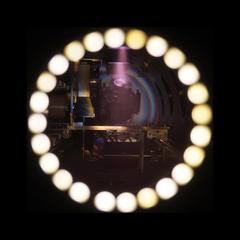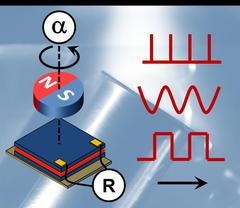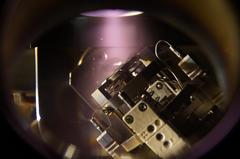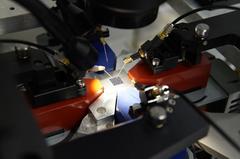URL: https://www.desy.de/news/news_search/index_eng.html
Breadcrumb Navigation
DESY News: Magnetic sensors custom made
News
News from the DESY research centre
Magnetic sensors custom made
Scientists at DESY have discovered a method that paves the way for a new generation of magnetic sensors. Their procedure can be used to greatly extend the functionality of such sensors, which is limited when conventional production methods are used, so that sensors can now be individually tailored to a wide variety of new applications. The scientists have presented their manufacturing process in the scientific journal Advanced Functional Materials.

A tailor-made vacuum deposition chamber (Andrey Siemens, Kai Schlage) is used to fabricate multilayer stacks with new sensor functionalities. One translation and two rotation motors position the wafer relative to the deposition sources and nanometer-thin film stacks are grown via subsequent deposition cycles. Credit: Kai Schlage, DESY
Magnetoresistive sensors are made up of microscopic stacks of alternating magnetic and non-magnetic layers, each just a few nanometres thick. When an external magnetic field is applied to such a multilayer stack, the electrical resistance of the stack changes. Although this giant magneto-resistive effect (GMR), for the discovery of which Albert Fert and Peter Grünberg were awarded a Nobel Prize in 2007, has revolutionised sensor technology, one problem has persisted: the magnetic field strength at which the resistor switches is largely fixed.
Researchers at DESY have now developed a procedure which allows them, for the first time, to take control of the magnetoresistive properties of multilayer sensor systems. Their method allows the field strength at which each individual magnetic layer in the minute stack switches to be precisely and flexibly adjusted. In addition, the preferential direction for the magnetisation of the individual layers, the so-called “easy axis”, can be in any chosen orientation. As a result, a multitude of new sensor properties can be achieved by straightforward means.

The new deposition procedure in oblique incidence allows scientists from DESY to freely adjust and to create new magneto-resistive sensor functionalities. The example shows a magneto-resistive trilayer and corresponding sensor characteristics (field dependent change in electrical resistance) which can be realized with the new technology. Credit: Kai Schlage, DESY
The improved sensor technology is based on a process known as oblique incidence deposition, or OID. The method, which is already used for single layers, allows arbitrary magnetic materials to be magnetically shaped on arbitrary substrates. The angle of deposition can be precisely varied and provides a simple way of determining whether a magnetic layer switches when the external magnetic field reaches a strength of 0.5 milliteslas or one hundred times that level. This corresponds approximately to the difference between 10 and 1000 times the strength of the Earth’s magnetic field.
DESY’s scientists discovered that this procedure can not only be used for single layers, but is also ideally suited for a large number of multilayer systems, thus considerably expanding the possibilities available in conventional design as well as the functionality of magnetic multilayer stacks. The researchers manufactured their multilayer systems in vacuum machines specifically designed for this purpose. The physicists then conducted experiments on the P01 beamline of DESY’s synchrotron radiation source PETRA III to precisely measure the magnetic properties of each layer of the stacks produced and were thereby able to demonstrate that OID permits arbitrarily complex and, most importantly, new magnetisation structures to be created in extensive multilayer stacks with extremely high precision.

View into the vacuum chamber during deposition of a nanometer-thin magnetic film. Both deposition angles determine the magnetic properties of the film and, thus, it’s sensing properties in the magneto-resistive film stack. The purple plasma is caused by the active deposition gun and illustrates the orientation of deposition. Credit: Kai Schlage, DESY
“Our procedure allows to produce magnetic sensors that deliver significantly more precise signals containing more information that are also easier to process,” says group leader Prof. Ralf Röhlsberger. “This allows for instance to monitor rotational movements much more precisely than possible today, significantly improving the safety of motors, drive units and engine control systems, especially under extreme conditions.”
The group has already filed a patent application for its method and hopes to demonstrate its commercial potential in a cooperative venture with industrial partners.
Reference:
Spin-Structured Multilayers: A New Class of Materials for Precision Spintronics; Kai Schlage, Lars Bocklage, Denise Erb, Jade Comfort, Hans-Christian Wille, Ralf Röhlsberger; Advanced Functional Materials, 2016; DOI: 10.1002/adfm.201603191

Experimental measuring station to characterize the sensing properties of the microstructured nanometer-thin film stacks. The tailor-made setup (construction by Toru Matsuyama, Lars Bocklage) allows generating rotary magnetic fields of well-defined strength while thin needle-probes are used to detect the change in electrical resistance. Credit: Kai Schlage, DESY



